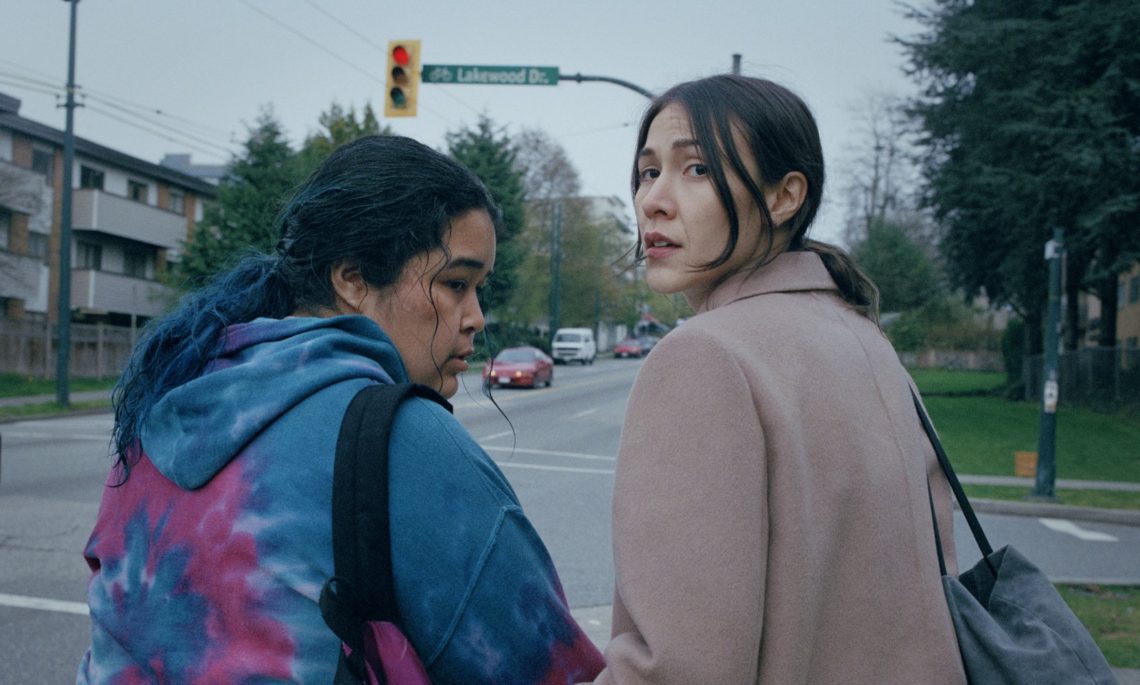
The Body Remembers When The World Broke Open Interview: Kathleen Hepburn and Elle-Máijá Tailfeathers
“I think people are listening right now. I think they are seeing that when women are telling the stories the representation of women are much more complex and nuanced and authentic, and that’s the way it should be.”
THE BODY REMEMBERS WHEN THE WORLD BROKE OPEN is a beautiful depiction of a chance encounter between two Indigenous women.
Shot as one long take, the film navigates many important themes through a conversation between these two women from very different backgrounds.
Fueled by strong performances by lead actresses, Violet Nelson (Rosie) and co-writer and co-director Elle-Máijá Tailfeathers (Áila), THE BODY REMEMBERS WHEN THE WORLD BROKE OPEN is a quiet, tense but stunning film that will stay with you long after watching.
We spoke with co-directors Tailfeathers (briefly as she stepped out of the edit suite) and Kathleen Hepburn about the logistics of filming, how the film trauma, and their recent distribution deal with ARRAY.
THE BODY REMEMBERS WHEN THE WORLD BROKE OPEN is currently playing at the TIFF Bell Lightbox.
Can you talk a little bit about yourself what you did on the film?
Kathleen Hepburn: I’m a Vancouver based writer-director. I had just finished my first feature Never Steady, Never Still the year before we started this project. Elle-Máijá and I had been sharing an office space out here in Vancouver and we’d been friends for a little while. She approached me with the project about two years ago and she was asking me to co-write and co-direct. She has mostly a background in documentaries and she was looking for someone with more narrative experience. She’d seen my film and knew my work and asked me to come on board and I was pretty thrilled to do so.
It was a really exciting concept to try and pull off this type of film in real-time and basically tell a story that was just two women talking for an hour and a half and make it in a way that was compelling and had tension and drama and suspense and humour. I came on board and we started writing.
Elle-Máijá Tailfeathers: I’m the co-writer and co-director and I also play Áila in the film. The film is inspired by an experience that I had that is very similar to what happened in the film. We fictionalized it and created two new characters to speak to the themes and topics that were of interest to Kathleen and me.
How long was the shoot?
KH: We only had seven days of shooting. We had two for the prologue scenes, which were more conventionally shot and then once the women meet it’s a continuous take so we shot once a day for five days.
How did you create the continuous take throughout different locations in Vancouver?
KH: As you can imagine it was a huge logistical challenge for us. We had inspiration from films like Victoria (2015, dir. Sebastian Schipper), which had pulled off something similar but in a much more heightened way. Ours is much more subdued.
We didn’t want it to take over the film. We didn’t want it to be flashy or to have people coming to the film just for this technical feat. We just wanted it integrated into the story in a way that helps us get into the characters emotional spaces.
It was extremely complicated in trying to find all the right locations that fit within the timing of our script and worked to keep the momentum going. We had to map out our entire neighbourhood and find the best route and make sure we narrowed down as many variables as we could.
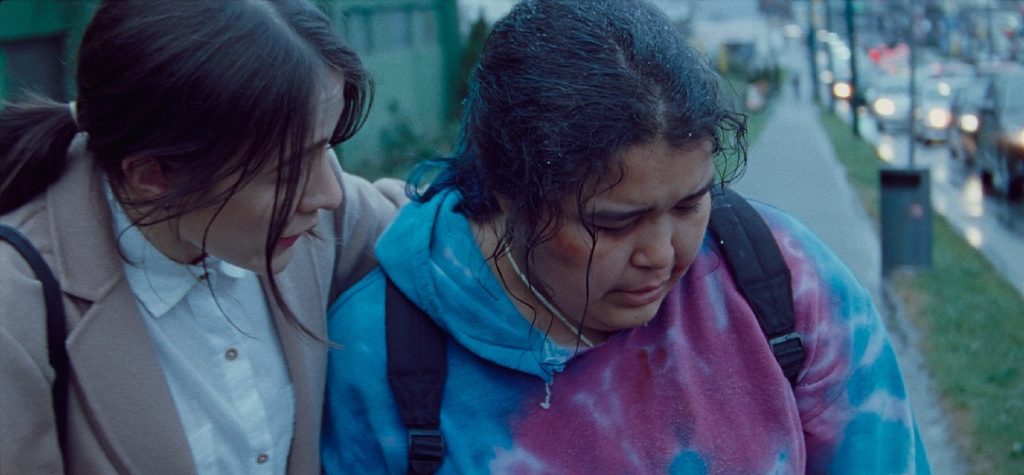
How did this work shooting on 16mm?
KH: We worked with a cinematographer named Norm Li, who is a really kind and generous person. He shoots primarily on film, myself as well, it’s just a very natural process for us. But the challenge was in shooting the continuous take.
In order to do that, he developed this method called Real-Time Transitioning. Because the film magazines only last for 11 minutes each and in order to have the actors be able to continue their action without stopping while we were shooting, we had to have these predetermined stitch points.
When the camera was about to run out he would be passed a second camera that was prerolling, and he would just continue his motion or repeat his motion and continue. It was a very, very fast transition but the actors didn’t have to stop their performance. It was obviously challenging but exciting.
In the beginning, you show Áila getting an IUD. I’ve never really seen this shown on screen. Can you speak about why you added this to the film?
KH: I think this film is so much about sovereignty over the body and sovereignty over Indigenous women’s bodies. We also haven’t seen this in cinema recently and we just wanted to reflect the female experience on screen.
I think for us, we wanted to talk about the tiny traumas we go through as women with our bodies on a day to day basis, and how power can play into that. When you’re in a situation with a doctor, who you should be able to trust, but it’s a man so there’s an inherent power balance. But it’s a lot more layered than that.
E-MT: We’re looking at an issue of class as well. When it comes to this issue of sovereignty of the body, especially for Indigenous women, class really impacts that.
We wanted to look at the ways that class and capitalism impact both Rosie and Áilas experiences with the world. Áila’s in the financial position to even have the choice to get an IUD, to access primary healthcare, she has the resources for those things. Where someone like Rosie doesn’t. She’s marginalized and disadvantaged in many ways, largely due to the Canadian state intervening in her right to exist and be with her community and her family.
The film is about domestic violence and while there is tension, you don’t actually see it depicted on screen. Why did you choose to shoot it in this way?
KH: The primary audience we were thinking about while we were writing were Indigenous women and Indigenous youth. We really don’t feel like it’s necessary to show violence on screen for women to understand the presence of violence. I think there’s a lot of very subtle cues that we can pick up on but to show violence on screen — no matter how you depict it—it glamourizes the situation or makes it feel thrilling.
We really wanted to stay away from that and not play into those ideas. We also wanted it to be a story told from the perspective of dealing with the aftermath of violence. So it wasn’t so much about the immediate situation of violence but how do we navigate the aftermath.
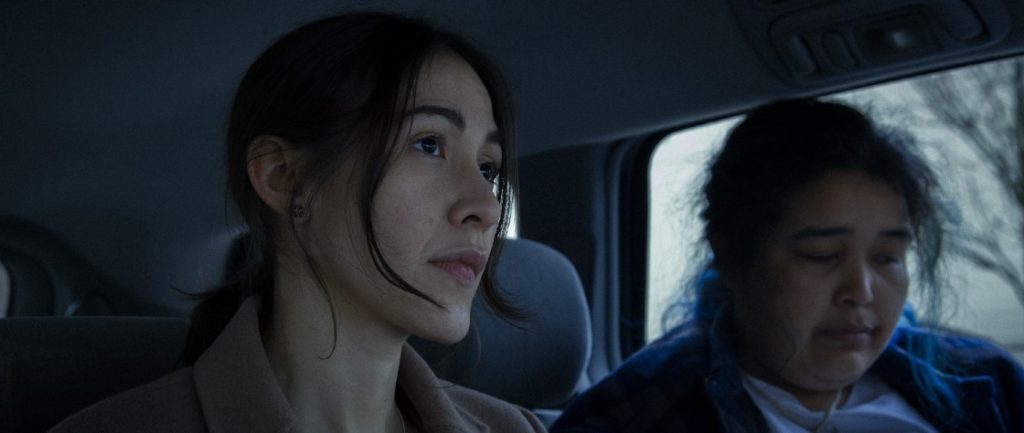
The film was recently picked up by ARRAY, how did that come about and how has this experience been for both of you?
E-MT: It’s been an incredible experience. There is a beautiful, thriving community of Indigenous filmmakers, but one of the main barriers we face is distribution and actually getting our films out to a broader audience, even to our own communities. They will play at festivals and then that’s it.
Often Indigenous stories are viewed as a niche, as not really having an audience, and Ava DuVernay and ARRAY have proved that idea very wrong. Clearly, there is an audience for this film, clearly, people want to see Indigenous stories on screen. So it makes a world of a difference to have a voice like Ava’s and a company like ARRAY champion our film.
I think it speaks to this broader relationship that’s being built in terms of alliances with Indigenous communities and Black communities, immigrant and refugee communities. The ways that people of colour and marginalized communities are working together to build new pathways and better pathways and thinking outside of the box.
This industry has been dominated largely by white men for a very long time and what we are learning is that their ideas are dated and it’s time for change.
People like Ava and her company are showing the ways that we can imagine a newer and brighter future. It’s just been so wonderful to collaborate, it’s just been a great opportunity to find a home with ARRAY as a distributor. It’s made a world of a difference.
It’s so surreal to see audiences in the US, in the UK, Australia, New Zealand, actually engaging with the story. A very simple story about two women in East Vancouver, Canada and to know that that story is resonating on a universal level with a broad audience — it means the world to us.
This is Violet Nelson’s first role, how did you find her?
KH: We had done traditional casting with a casting director and had seen a lot of young actors and they were all great but, we didn’t find that magical piece that we were looking for. So we did an open casting call and spread it around to all sorts of communities to get a really broad net.
We had seen Violet in a music video and we asked her to come in a do a tape. Her side of the story is a little bit different. She talks about a friend who had passed on the casting notice and told her to spread it around and that she could go out for it if she wanted. She wasn’t interested.
Then her mom gave her a hard time about it and said ‘What’s the worst that could happen?’ So we saw her tape and there was something so special about her that we had her come in. It was just that instinct, meeting her and seeing how empathetic she is. Just the story her face tells. We fell in love with her very quickly.
It was a very emotional role and it was very challenging. We had to make it very clear to her that she could walk away if she wanted to and tried to give her the support she needed. She did so good.
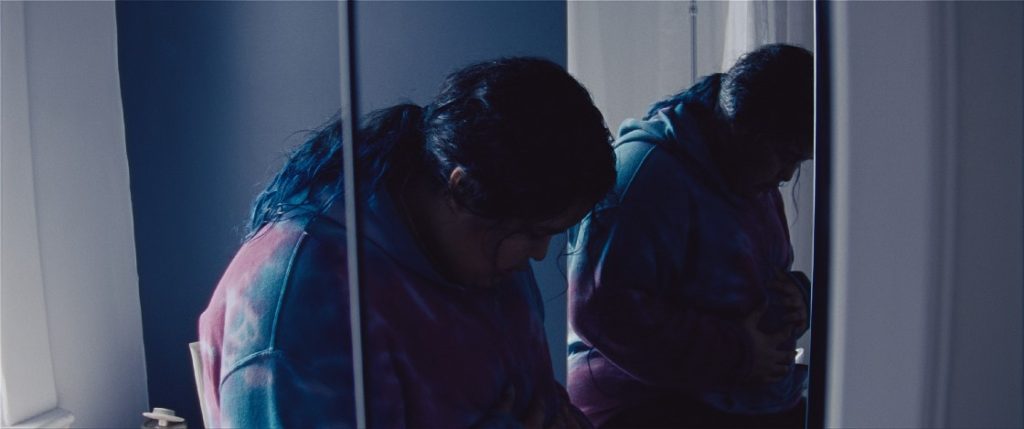
Can you speak more about the support on set and how you as a community dealt with this day to day?
KH: It started in the development process. We knew it was a difficult subject matter and that we would be working with a young person and we wanted to do no harm and make sure the character was authentic. We workshopped the script with six young Indigenous youth, women who had been through foster care, to make sure the depiction was accurate and get a better understanding of the character. That was very useful in terms of us understanding the challenges that could come up and which parts might be triggering.
We developed a youth mentorship program. We had 11 Indigenous youth paired up with key crew members, they were all paid and were all part of the team. We were trying to create a more collaborative, reciprocal creative partnership. We had all these youth on board so we were very aware we needed to be careful about the tone on set and how everyone was treating each other.
We did a sort of Indigenous History 101 workshop at the start during prep where we brought in a really incredible law student who talked about the representation of Indigenous women on screen and also violence against women. That was huge in terms of having our crew all on the same page about why we were telling the story and how we needed to be kind and careful with one another.
We also had Violet seeing a counsellor once a week and we had an elder on set who, we didn’t know this at the time but, was actually from her same community. That was a really nice connection for Violet.
Can you tell us why you’re a feminist and why it’s important to your filmmaking?
KH: I think I was just born a feminist. I grew up around strong women and it just seemed like not an option not to be. I want to be able to do whatever I want to do in my life and I don’t want gender to be a barrier to that and I don’t think it should be. I think it’s time for women to take control of representation on screen. I think people are listening right now. I think they are seeing that when women are telling the stories the representation of women are much more complex and nuanced and authentic, and that’s the way it should be.
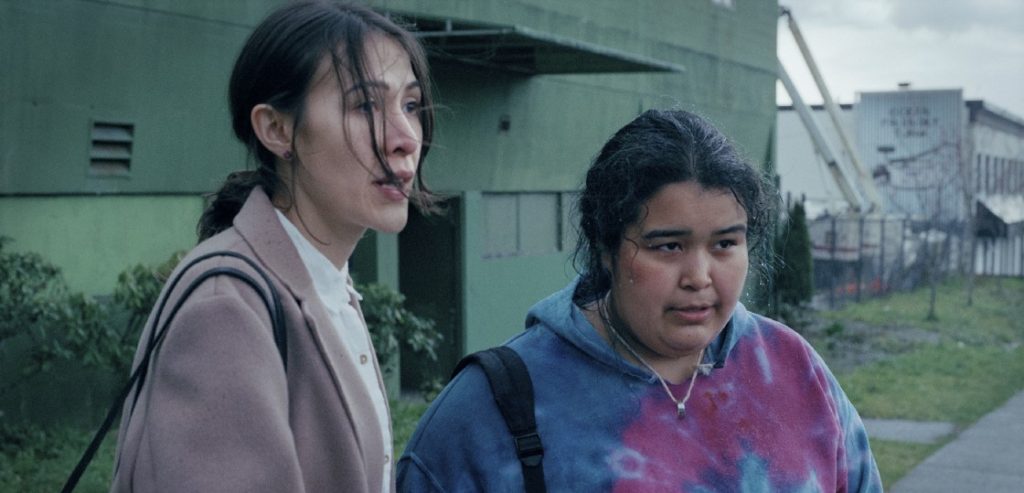
What are you working on now/next?
KH: I’m working on a few things, the most far along project would be developing a television series with another collaborator Elizabeth Cairns. It’s a coming of age slash detective series, so that’s quite exciting. And just starting on the beginning stages of the next feature.
I can talk a little about what Maija’s working on. She’s been working for quite a few years on a documentary about the fentanyl crisis in her home, which is on the Blood Reserve in Alberta. She’s now going into editing on that and is working with the NFB. She is also developing her next feature which will be an adaptation of a novella.
Finally, recommend one #MUFFApproved film for our blog readers.
KH: One film that was a strong reference film for us was Wendy and Lucy by Kelly Reichardt.
Keep up to date with The Body Remembers When The World Broke Open: Facebook | Twitter
*This post was originally featured on The MUFF Society.*

